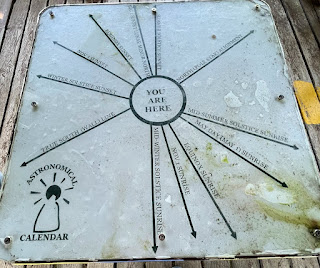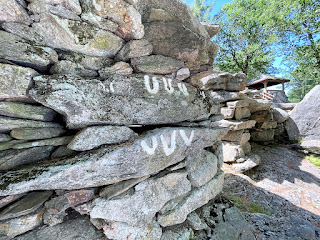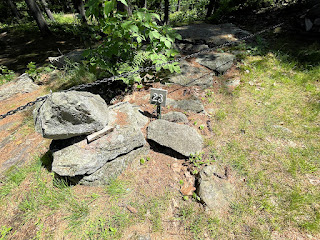After visiting
Mt. Agamenicus, Teague and I continue our journey home stopping at America's Stonehenge (also called Mystery Hill) in Salem, New Hampshire.
The place is fascinating and a bit underwhelming. The use of Stonehenge makes one think of the giant trilithon structures of Stonehenge on the Salisbury Plain in England. and that's not the kind of structure seen here in New Hampshire. In fact, most of the stonewalls look very typical of New England where farmers had stone walls to mark boundaries and pastures or were foundations for homes,barns, and other outbuildings. The height of these structures seemed to be between 5 and 6 feet. We were able to walk through the Oracle Chamber. I'm a little over 5 feet tall and could stand upright in the structure without having to stoop over.
Not much is known about who built this site. Ancient calendar or a PT Barnum place to draw in the crowds? Who knows. That's the mystery. It was a pleasant place to spend a couple of hours in the fresh air and to get a good walk in.
Even though I changed the code so Blogger would upload my photos in first to last order, Blogger decided to start backwards.
If you want and you have a smartphone, you can download the America's Stonehenge tour app from your app store. Descriptions of the photos are from selections from the app.
There are also alpacas. This fellow came out to pose.
A big rock, but I can't seem to match it up to what it aligns with.
Grooved Table
4.5 tons and believed to have been used for ceremonial purposes.
Summer Solstice Sunrise Alignment
This is a ley line and if you follow the line through the Summer Solstice Sunrise stone, it will go directly through one of the trilithons at Stonehenge in England.
Astronomical Viewing Platform
Exit to Ramp Drain
This drain began over at the V Hut and exits here.
On the left wall just after the stone seat near the letter H is a very weathered inscription outlined in white. It is a carving of an antlered deer.
Another passageway of the Oracle Chamber
Inside the Oracle Chamber
Oracle Chamber Entrance
Sundeck Chamber
This chamber faces East and may have originally been the end of the East-West Chamber. The stonework above the roof of this chamber was restored in the 1980s and is believed to have been modified several times.
2000 B.C. Excavations
This area is one of the most important discoveries found on the site, as it produced three key carbon dates. Rotted pine roots found in the walls during a 1967 excavation dated the site to 1690 A.D. This proved that the walls were there prior to the Pattee family. In 1969, charcoal had sifted into the walls was found below these roots at 2 - 4 inches above the bedrock, and dated the site to 1400 B.C. In 1971, a third and older date of 2000 B.C was obtained.
Pathway to the Oracle Chamber
Large Wall
This is yet another example of ancient constructing techniques versus modern. A trained eye may notice that that bottom half of this wall is of much better construction thant the top half that was reconstructed by Goodwin's crews in the 1930s
Drilled Ledge and Drains
Water flowing from the drain below at Site 22 pases down into this area then under the broken roof slab at Site 11.
Drain Exit
This area shows the vast amount of labor that was involved in creating this site. On a rainy day, water can be seen running through the cracks and channels that have been cut into the granite. The drains still work to keep the area dry
Mensa Stone
The Mensa Stone weight an estimated 6 to 8 tons. It appears to have been cut and raised to form a table of sorts. If you look at the wall above the Mensa Stone, you will be exable examine the differences between the ancient stonework and modern. It is known that Goodwin added the upper 12 to 18 inches of the wall in the 1930s.
Restoration
Restoration
This is a continuation of the East-West Chamber, and was restored during 1978, 1979, and 1980 by using pre-Goodwin-era photos.
East-West Chamber
This chamber was formerly known as The Tomb of Lost Souls because of its similarities to structures found on ancient European megalithic sites called Galler Graves.
The V Hut
This chamber was named for its wedged shape. In Western-Europe, similar huts in the shape of a V came to be known as wedge tombs.
Compound
A large structure once stood in this area. The foundation stones are much larger than those of the largest chambers on the site. It has been suggest that a small window in which light would pass through may have existed in the original chamber and would be in line with the Winter Solstice sunset
the 90-degree hole
90-Degree Hole
On the North face of the stone there is a marking that is referred to as a double-headed axe symbol. It has been suggested that this worn area was used to sharpen stone axes and other tools.
Quarry Post Socket
This feature is further evidence of the quarrying done on the site
The Pulpit
William Goodwin named the site The Pulpit because of his theory that Irish monks built the site.
South Facing Chamber (The Lilac Chamber)
Nicknamed The Lilac Chamber because of the lilac bushes on top that were likely planted by Mrs. Pattee
True South Point Wall
This wall points true South
Undetermined Structure
Two large slabs of stone from what was once a roof slab similar to those found in the construction of the Oracle Chamber
The Patee Area
This was once the basement of the Pattee Family's home. This also may have been a stop on the Underground Railroad helping slaves from the South heading North to Canada to gain their freedom. A mancle was found here and is on display in the museum
Carved Circle and Tool Sharpening Groove
The crudely carved circle with the hole in the center may be a modern addition to the used used to make lye soap. Another explanation could be its use as a sundial. The groove may have been used to sharpen stone and antler tools.
The Upper Well (Well of Crystals)
Quartz found in this well came from a natural vertical fault in the bedrock
Sump Pit
This drain may have helped keep the adjacent chamger in the Pattee Area Dry. Pattee was the family that owned the property in the 1800s
Entrance to the Main Site
Lower Well and Clay Deposit
The inclusion of wells in stone wall is common in ancient sites, and is not considered part of the colonial period in America
The Double-Walled Pathway
leads to the main site
The Serpent Wall
is the largest of several serpent effigies on the site. This particular wall wraps entirely around the hill encircling 15 or so acres. The boulder which form a wall of the Watch House Chamber is the head of the serpent.
The Watch House is also a February 1st (pagan festival of Imbolc) sunrise alignment. The first sunlight of the day will shine into the opening and illuminate the chamber
The Watch House
The original purpose of the chamber is not known. Stone and bone pendants were found which might indicate the chamber was used as a burial structure.
The Pope Road Nature Trail
This area is also a conservation site for many animals, plants, and especially Bluebirds



















































